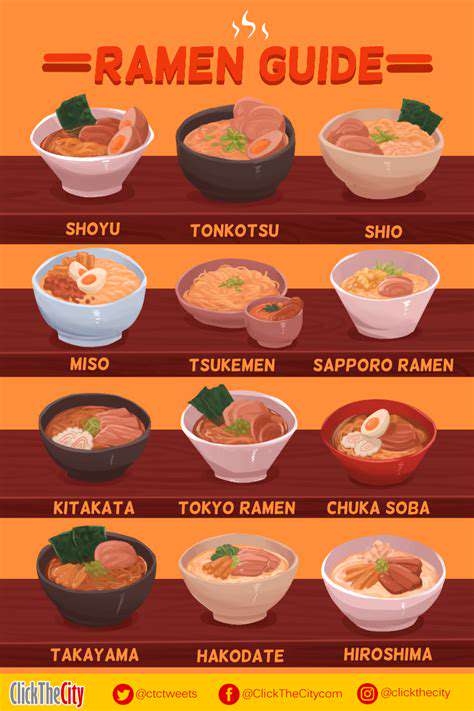Authentic Japanese Ramen: Broth and Noodles
The Foundation of Flavor: Building the Perfect Broth
Ramen broth is more than just a liquid; it's the heart and soul of the dish. The depth, complexity, and nuanced flavors inherent in a well-crafted broth are what elevate ramen from a simple noodle soup to a culinary masterpiece. From the initial simmering of carefully selected ingredients to the final, delicate touch of seasoning, the process of creating ramen broth is a meticulous dance of techniques and patience. Understanding the foundational ingredients and the precise timing of their additions is crucial for achieving the desired flavor profile.
A truly authentic Japanese ramen broth, whether a rich tonkotsu or a savory shoyu, is the result of long hours of simmering. This slow cooking process allows the flavors of the ingredients to meld and deepen, creating a harmonious symphony of tastes. The use of high-quality ingredients, including pork bones, dried bonito flakes, and flavorful vegetables, is essential for producing a truly exceptional broth. The precise ratio of these ingredients and the delicate balance of spices and seasonings contribute to the unique character of each type of ramen.
Beyond the Basics: Exploring Variations and Techniques
While the fundamental principles of ramen broth remain consistent, various regional styles and traditions offer a plethora of variations. From the creamy richness of tonkotsu, derived from pork bones, to the savory depth of shoyu, which relies on soy sauce as a primary flavoring agent, each type of broth tells a story of its own cultural heritage. Understanding these nuances allows for a deeper appreciation of the diverse world of ramen.
Beyond the core ingredients, techniques like slow simmering, careful skimming, and the judicious use of aromatics play critical roles in shaping the final product. The precise timing and temperature control during the cooking process are essential for extracting the maximum flavor from the ingredients while preventing bitterness or other undesirable flavors. Each step of the process, from selecting the right ingredients to mastering the cooking techniques, contributes to the complex and layered flavor profile that defines authentic Japanese ramen.
Furthermore, the use of dashi, a traditional Japanese broth, often forms the base for many ramen broths. Dashi, typically made from dried kelp or bonito flakes, imparts a distinct umami flavor that complements the other ingredients and enhances the overall depth of the broth. Understanding the various types of dashi and how they are incorporated into different ramen styles is key to appreciating the nuances of this culinary art form.
The careful consideration of seasoning is also vital. The addition of salt, soy sauce, or other seasonings needs to be precise and balanced to ensure a harmonious flavor profile that enhances the natural flavors of the broth. The interplay of these elements creates a rich and complex taste experience that is central to the appeal of authentic Japanese ramen.
Exploring the different techniques and variations in ramen broth allows one to delve deeper into the culinary artistry of this Japanese tradition. This exploration unveils the intricacies of each style, highlighting the meticulous care and attention to detail that go into crafting these exceptional broths.

Anxiety, a common mental health concern, often manifests with a range of physical symptoms. While many factors contribute to anxiety, a surprising and often overlooked aspect is dehydration. The body's intricate systems rely heavily on water for optimal function, and when levels dip below optimal, various physiological processes can be disrupted, potentially leading to heightened feelings of anxiety and nervousness. This subtle connection highlights the importance of proper hydration in managing overall well-being and anxiety.
Beyond the Basics: Garnishes and Toppings

Beyond the Basics of Garnishing: Elevating Your Culinary Presentation
Garnishes are more than just pretty additions to a dish; they play a crucial role in enhancing the overall dining experience. A thoughtfully chosen garnish can elevate the visual appeal, adding a touch of artistry and sophistication to even the simplest meal. They can also subtly influence the flavor profile, bringing complementary or contrasting notes to the main course.
Beyond the aesthetic appeal, garnishes can also provide important textural elements. The crunch of a fresh herb, the smooth glide of a drizzle of sauce, or the satisfying bite of a crisp vegetable can add another dimension to the eating experience, making the meal more engaging and satisfying.
The Art of Flavor Pairing in Garnishes
Understanding the interplay of flavors is key to effective garnishing. A garnish should complement the dish's primary flavors, not overpower them. For example, a citrus-based dish might benefit from a sprig of fresh rosemary or a lemon twist, adding a touch of brightness and freshness without overpowering the dish's primary flavors.
Consider the dish's overall flavor profile when selecting a garnish. A rich, savory dish might benefit from a sprinkle of toasted sesame seeds or a crispy fried onion, while a light and refreshing dish might be perfectly complemented by a delicate flower or a sprig of mint.
Ingredient Selection: Freshness and Quality
The quality of the ingredients used for garnishing is paramount. Fresh, high-quality ingredients will yield the best results, providing the optimal flavor and texture. Using wilted herbs or overripe fruits will negatively impact the overall presentation and diminish the dining experience.
Seek out the freshest ingredients possible. This ensures maximum flavor and aroma, creating a more vibrant and appetizing garnish. A simple salad can be transformed with a handful of fresh, vibrant berries, or a simple drizzle of extra virgin olive oil.
Beyond the Traditional: Exploring Creative Garnishes
While classic garnishes like edible flowers and citrus slices are always effective, don't be afraid to experiment with more unusual options. Consider using edible flowers, microgreens, or even edible insects for unique and visually striking results.
Innovative garnishes can truly set your culinary creations apart from the crowd. Using unusual combinations of ingredients can create a visually stunning and memorable dining experience. The possibilities are endless, limited only by your imagination and the availability of fresh ingredients.
Presentation Matters: The Role of Garnish Placement
The placement of a garnish is just as important as the garnish itself. A strategically placed garnish can draw the eye and enhance the visual appeal of the entire dish. Pay attention to the overall balance and symmetry of the plate when arranging your garnishes.
Careful consideration should be given to the plate's overall appearance. Avoid overcrowding the plate with garnishes, as this can detract from the dish's visual appeal. A few well-placed elements are often more effective than a multitude of small, scattered garnishes.
Practical Tips for Effective Garnishing
Employing simple techniques can significantly impact the overall outcome of your garnishing efforts. For example, consider using a small spoon or toothpick to precisely place delicate garnishes. Knowing how to use tools like these can make all the difference in creating a professional and polished appearance.
Properly storing and preparing garnishes in advance can save time and ensure freshness. Knowing how to prepare and store ingredients for garnishing allows for quicker meal preparation and enhances the entire culinary experience. Proper handling of ingredients can also help in maintaining the quality and freshness of your garnishes.
The Culinary Significance of Ramen

A Staple in Japanese Cuisine
Ramen, a ubiquitous dish in Japan, holds a profound cultural significance, extending far beyond its simple noodle-soup form. It's a testament to the country's rich culinary heritage, reflecting the evolution of Japanese taste and the adaptability of its ingredients. Ramen isn't just a meal; it's a cultural experience, a reflection of Japanese ingenuity and resourcefulness in creating a delicious and satisfying dish. The diverse regional variations, from the savory tonkotsu broth of Kyushu to the rich shoyu-based varieties of Tokyo, showcase the depth and breadth of Japanese culinary traditions. Ramen's popularity has transcended its origins, becoming a global phenomenon, yet it continues to be cherished as a beloved national dish in Japan.
The history of ramen is intricately linked to the development of Japanese society. Initially, ramen was a relatively simple dish, made with readily available ingredients. However, as Japanese society progressed, so did ramen, evolving into the complex and flavorful dish we know today. The evolution of ramen reflects the country's ability to adapt and innovate, using simple ingredients to create a sophisticated and satisfying meal. This adaptability is a key part of its enduring appeal, allowing it to be enjoyed by people from all walks of life, and to continue to evolve and inspire new creations.
Regional Variations and Culinary Innovations
The beauty of ramen lies in its regional variations. Each region of Japan boasts its unique take on the dish, reflecting local preferences and culinary traditions. From the rich and creamy tonkotsu broth of Kyushu, known for its pork-based richness, to the more delicate shoyu-based broths of Tokyo, the variations are endless. The use of different types of noodles, toppings, and seasonings further enhances the diversity of this culinary masterpiece.
Beyond the traditional variations, ramen continues to evolve with modern culinary innovations. Ramen chefs are constantly pushing boundaries, experimenting with new flavor combinations and incorporating innovative ingredients. This ongoing evolution ensures that ramen remains a vibrant and exciting culinary experience. Modern ramen shops are often more adventurous with the toppings and seasonings, creating truly unique and unforgettable dishes.
Ramen's versatility also extends to its adaptability for various dietary needs and preferences. Vegetarian and vegan options are increasingly available, demonstrating the dish's capacity to be tailored to different dietary requirements. This inclusivity further solidifies ramen's position as a widely appreciated and adaptable dish.
- Buying Organic Produce: Is It Worth the Cost?
- Oven Baked Dinners: Less Mess, More Flavor
- Discovering Korean BBQ: Essential Marinades and Grilling Tips
- Baking Gluten Free Brownies: Fudgy and Delicious
- Homemade Brownies: Fudgy and Irresistible
- Low Sugar Baked Goods for Diabetics: Smart Choices
- How to Store Fresh Seafood: Keep It Safe
- Storing Nuts & Seeds in Freezer: Prevent Rancidity
- How to Store Fresh Corn: Keep It Sweet
- Exploring Scandinavian Cuisine: Gravlax and More
- Low Calorie Snacks for Weight Loss: Smart Choices
- Vegetarian Breakfast Ideas for Weight Loss: Smart Choices